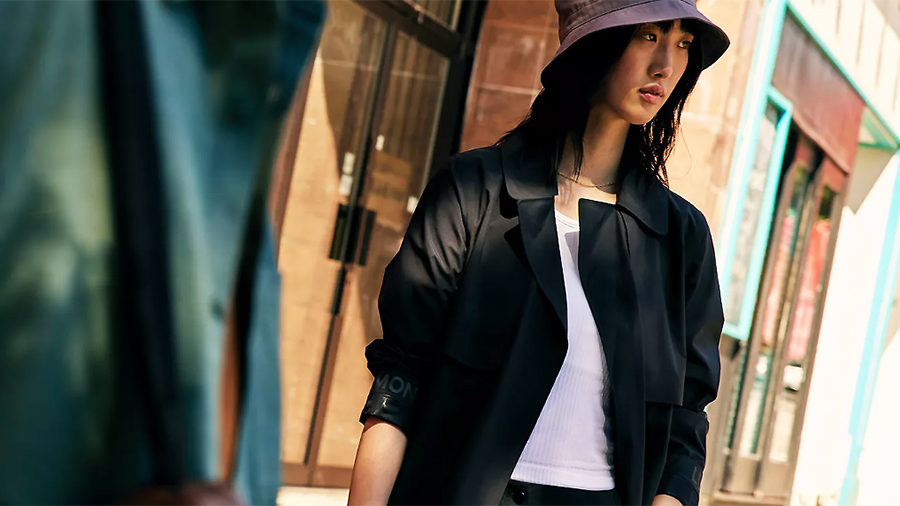Stretchy casual office wear that has become more acceptable amid the pandemic-fueled work-from-home trend is expected to drive global sales in the athleisure market by 25 percent to $551 billion by 2025, according to U.K.-based GlobalData.
According to GlobalData’s 2022 Q1 Consumer Survey taken in March, on a global scale, two out of five consumers have continued to work from home in 2022. As a result, demand for athleisure wear remains high.
However, in its 2021 Sportswear Survey, the data showed that 55 percent of global consumers wore athleisure items for more than sports participation, forecasting the ongoing casualization would make its way into traditional office settings as many return to work.
Louise Deglise-Favre, the apparel analyst at GlobalData, commented, “People have simply been able to get more wear out of athleisure clothing while working from home over the pandemic. Now, with hybrid working set to continue, people will still want to dress casually and work out on the days they are not in the office. As for in-office working, we expect that to become more casual, too. Trainers at the office and the sweatshirt-under-a-blazer look will be more popular. This traction will help the sportswear market grow by an impressive 25.1 percent to $551 billion between 2021 and 2025.”
GlobalData’s latest Global Sportswear Market 2020-2025 report shows that one-quarter of apparel sold in 2020 was sportswear as more consumers both worked out from home and worked from home. While the share of sportswear is expected to decline slightly in 2022 as consumers switch back to dressier items for social events, sportswear will remain popular for home, work and workouts, which will increase its share of the apparel market 23.6 percent by 2025.
Deglise-Favre continued: “As hybrid working continues and brands embrace the casualization trend, consumers will continue to want more multifunctional, comfortable athleisure pieces appropriate for both wearing at home and in social settings. However, technical sportswear—Clothing that presents performance characteristics used exclusively to practice a sport—–will also be important as consumers continue to prioritize their health and fitness, and team sports are due to have their first full year without disruptions. The uptake in outdoor activities and cycling started by the pandemic is also expected to continue in 2022 and beyond, boosted by the representation of mountain activities in the Beijing 2022 Winter Olympics.”
Several other studies over the last year have similarly predicted a shift toward “workleisure,” or athleisure items that are appropriate for the workplace.
Lululemon Survey Finds Casual/Comfortable Clothes Boost Job Performance
Last August, Lululemon conducted a survey of 20,000 consumers across 11 global markets and found that 80 percent respect companies that allow their employees to wear casual clothing, with 38 percent of millennial respondents saying that they would consider leaving their job if a professional dress code was enforced. This number was greater in the U.S., with more than half (56 percent) of millennial men saying they would consider looking for another job over returning to corporate workwear.
The key global findings of Lululemon’s study show that more casual and comfortable attire does the following:
- Improves Performance: 8-in-10 (81 percent) of respondents said they perform better at work when they dress comfortably. The majority of adults want employers to recognize that the quality of work employees deliver is more important than their clothing (86 percent).
- Creates Connection:3-in-4 (76 percent) of respondents said casual dress codes in the workplace help people get to know each other more genuinely.
- Impacts Confidence: Comfort, according to 96 percent of respondents, is the most important thing when choosing clothes, and 3-in-4 (74 percent) said the clothes they wear impact their confidence.
- Inspires Employee Respect: Over 4-in 5-(84 percent) of respondents respect companies that allow their employees to wear casual clothing to work.
- Increases Loyalty: More than one-third of Millennials (38 percent of respondents) would consider leaving their job if their employer made them dress professionally to work.
- Intersects with Style: 3-in 4 (74 percent) of respondents do not want to choose between feeling comfortable and looking good in their clothes.
- Supports Versatility: Among adults returning to their previous workplaces, 82 percent said they would shop for clothes they can wear both to work and outside of the office.
“The data provides long-overdue recognition that professional workwear can, and should, be functional, versatile and comfortable, and when it is all three, it can positively affect performance, confidence and more,” said Lululemon’s Chief Product Office Sun Choe.
Nordstrom Survey Finds Strong Shift Toward Relaxed Dressing
Last July, Nordstrom released a survey of 2,000 Americans exploring how the pandemic had affected their fashion choices, and it showed 41 percent plan to dress comfortably for the remainder of their lives; however, the survey also found that they aren’t giving up style for comfort as 35 percent said they are more open to trying new styles post-pandemic.
“It’s been exciting to see customer demand come back in occasion categories, whether travel, social or work. There is great enthusiasm for celebratory dressing—color, print and new silhouettes,” said Shea Jensen executive vice president, general merchandise manager, women’s and men’s apparel. “Customers are looking for ways to refresh their closets after a year of mostly staying home—from new occasion wear, such as a suit or dress for an upcoming event to new pieces that offer versatility from day to night.”
Other findings from Nordstrom’s survey:
- Thirty-six percent said they had not purchased new work clothing since before the pandemic. For those planning to return to an office in the fall, they were excited to get out of their “comfort” zone and said yes to dress pants (28 percent), dress shirts (28 percent) and dresses (26 percent).
- Forty percent of respondents felt stuck in their personal style, and 1-in-4 said their wardrobe felt outdated.
- When it comes to special occasion dressing, respondents were looking for help finding looks for dining out (32 percent), events (34 percent), travel (21 percent), and work (20 percent).
Photo courtesy Lululemon
















